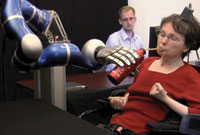Office of Research & Development |
 |


VA researchers and colleagues reported in the May 16 online edition of Nature that two study volunteers with tetraplegia—paralysis of all four limbs and the torso—were able to grasp objects with robotic arms that they controlled with their own thoughts. They used an investigational system called BrainGate, which harnesses brain signals to command external devices.
One of the participants, a 58-year-old woman, was able to pick up a bottle of coffee and bring it to her lips to drink. This was the first time she was able to serve herself since she became paralyzed nearly 15 years ago.
The research team included scientists from the Providence VA Medical Center, Brown University, Massachusetts General Hospital, Harvard Medical School, and German Aerospace Center.
The woman and a 66-year-old man, who is a Veteran, took part in the research. They had each been paralyzed by a brainstem stroke years earlier that robbed them of control of their arms and legs.
The research involved two different robotic arms. One, the DLR arm, was developed by the DLR Institute of Robotics and Mechatronics as an assistive device. The other, the DEKA arm, was developed as a prosthetic arm by DEKA Research and Development, through funding from the Defense Advanced Research Project Agency. VA and DARPA have worked with DEKA engineers and Veterans with limb loss in a separate study designed to optimize the arm's design and function.
Early work on BrainGate took place at Brown University, and VA has helped fund its continuing development. The system uses a tiny brain implant about the size of a baby aspirin, with nearly 100 electrodes. It is placed just under the skull on the brain's motor cortex, which helps control movement.
The electrodes, or sensors, are close enough to individual brain cells to pick up their impulses. A wire bundle runs from the electrodes and outside the body to a computer that translates the signals into commands for devices.
In past studies, BrainGate volunteers achieved point-and-click control of a cursor on a computer screen, and basic control of a simple robotic device. The new findings are the first demonstration and peer-reviewed report of people with tetraplegia using brain signals to control a robotic arm in three-dimensional space—as opposed to a two-dimensional computer screen.
The volunteers used the robot arms to reach for and grasp foam targets that were placed in front of them, held by flexible supports. The woman also used the DLR robot to pick up a bottle of cinnamon latte, bring it to her mouth, drink through a straw, and return the bottle to the table.
BrainGate pioneer John Donoghue, PhD, MS, recalled a moment in the research that can be seen in a video of the experiments that was made available to the media: "If you just watch her reaction after she picks up the cup [and drinks], that smile captures everything."
"Her smile at the moment is something I, and our research team, will never forget," added his colleague, lead author Leigh Hochberg, MD, PhD.
Donoghue is a neuroscientist with VA and Brown. Hochberg is a neuroengineer with VA, Brown, Massachusetts General Hospital, and Harvard.
Significantly, even after a decade and a half, the motor cortex part of the brain that was "disconnected" from its original target by a stroke was still able to direct the complex movement of a robotic limb. The brain cells, in essence, had "remembered" how to send the right signals.
The researchers also noted that the woman was able to perform the tasks more than five years after the BrainGate electrode array was implanted. They said this sets a new benchmark for how long implanted electrodes can remain viable and provide useful command signals.
Neuroscientist Andrew Schwartz, PhD, of the University of Pittsburgh, who is collaborating with other VA investigators on similar work, told the Associated Press that the VA-Brown-MGH findings "show that this technology has therapeutic potential. The field is rapidly advancing, and I think this offers hope for people who are paralyzed."
A separate VA-funded brain-compute interface study at the Durham VA Medical Center is exploring the use of an electrode-studded cap, worn over the skull and aimed at picking up broader brain signals.
All the projects aim to eventually restore some level of independent function to Veterans and others with ALS (Lou Gehrig's disease), spinal cord injury, brainstem stroke, and other conditions that result in paralysis. As shown in the latest BrainGate experiment, the technology may also be used in the future to help those with limb loss control a prosthetic arm, using only their thoughts.
In its current version, BrainGate requires a wire bundle running from the patient's brain, through a small pedestal on the skull, to a computer that sits on a nearby cart. The BrainGate team is developing a wireless, fully implantable system and already has a prototype in testing.
The ultimate goal, said Donoghue, is a system that's virtually invisible to others, so users could "interact with the environment without anyone knowing they're using a brain-machine interface."
The BrainGate2 study continues to enroll participants to take part in this research. It recently added Stanford University as a trial site and a member of the collaboration. To learn more and view a video of the work, visit Brown's website at http://news.brown.edu/pressreleases/2012/05/braingate2 or the BrainGate website at www.braingate2.org.